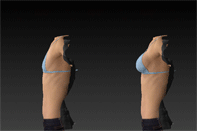Do you know why plastic surgery is called plastic surgery? If we were to ask a group of people where they believed the term “plastic surgery” comes from, we’re guessing most of them would say it has to do with the fact that various implants are made of plastic.
It’s a common misconception that plastic surgery was named as such because of the materials used in certain procedures, such as breast implants. In fact, the term plastic surgery was coined way back in 1798 and breast implants themselves were not developed, in their more recent form, until the early 1960’s.
If the term is not named for the type of material used in breast implants, then why is it called plastic surgery?
Plastic Surgery vs. Cosmetic Surgery
In recent years the term “cosmetic surgery” has started to replace plastic surgery, but there are still a lot of people around the world that lump all of these types of procedures as “plastic surgery”.
“Plastic” in plastic surgery is derived from the Greek word plastikos, which means to shape or mold something. So, as you can see, this term fits very well with the types of surgery and procedures that surgeons are performing.
These surgeons are molding and shaping your body in different ways to enhance or change your features. They are considered by many to be modern day artists, just working in a different medium.
Cosmetic surgery and plastic surgery are used interchangeable depending on who you’re talking to. Some doctors like to refer to it as cosmetic surgery these days because of the idea that many people believe that “plastic” is talking about the material used during the procedures, but in theory plastic surgery and cosmetic surgery are different.
Plastic surgery is an all-encompassing term that includes cosmetic surgery as well as reconstructive surgery. These two types of surgery are actually quite different even though there is a bit of an overlap in the methods and procedures used.
Cosmetic Surgery vs. Reconstructive Surgery
Cosmetic surgery typically refers to just that, surgical procedures designed to improve your body in a cosmetic way. This usually means that there is nothing “wrong” with a patient, but they desire to have changes made to their bodies.
These types of procedures would include things like breast augmentation, facelifts, liposuction, and things of that nature.
Reconstructive surgery typically refers to surgery that is required to help correct functional impairments caused by injuries, burns, genetic defects, cancers, and more. These procedures are designed to help a person lead a more normal life when affected by something out of their control.
These procedures can be performed to help a person look a certain way after an accident or gain functionality or mobility that they may have lost due to an accident or illness.
So, while cosmetic surgery is there to provide people with a way to improve their appearance mainly from an aesthetic point of view, reconstructive surgery is designed to repair damage that a person may have incurred from some external source or genetic abnormality.
Plastic Surgery
Plastic surgery used to be frowned upon, but more and more people these days have begun to open up to it. We’ve seen a huge influx in the amount of people undergoing plastic surgery procedures and non-surgical procedures, while also spending more money on these surgeries than ever before.
If you have any questions about cosmetic surgery or reconstructive surgery, please contact us today at Dr. Adams Plastic Surgery. We will be happy to answer any questions you may have regarding the various cosmetic procedures that we offer.















